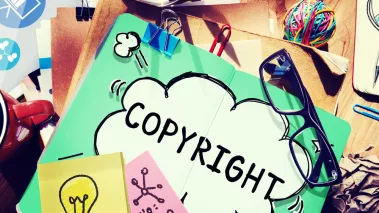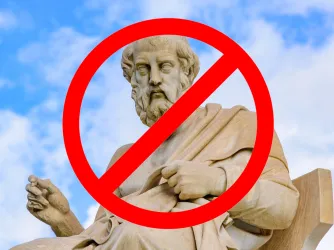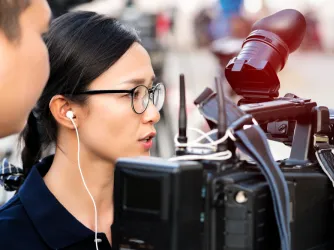Table of Contents
SPFI hotline: Does the paper own the copyright?

Shutterstock.com
Day and night, FIRE’s Student Press Freedom Initiative answers hotline calls from student journalists with questions about defamation, First Amendment issues, copyright, and more. Each month, in order to spread the knowledge we share on the SPFI hotline, we’ll highlight one question we answered and talk through ways student journalists across the country can think through these issues.
This month’s question: Who owns the copyright to content produced by student publication staff?
The short answer: It depends, and best practice is to have a clear agreement on file with each staff member to provide clarity. (We have a sample!)
The long answer: Imagine this: In 2020, a photographer for your newspaper, University Times, took a picture of a Black Lives Matter protest on campus. It was published alongside a news article discussing the protest. The photographer graduated May 2020. Now, University Times wants to publish a feature discussing what changes have been made to campus policies since the 2020 protests, and you want to use that 2020 picture to illustrate the story. But can you? Will you be violating copyright by republishing the photo?
The answer isn’t necessarily clear-cut. It depends on the publication’s employment relationship with the photographer and any agreements you might have in place with staffers related to use of their copyrighted works.
Copyright basics
To get to the bottom of this, we first need to understand how copyright works, on the most basic level.
How do you get a copyright?
A lot of folks think that in order to secure a copyright, an author must register the content with the U.S. Copyright Office. This is not true. All one needs to do to secure a copyright is create an original work and put it “in a tangible medium.” This means any creative work you have made that is somewhere other than your brain — a piece of paper, a canvas, an SD card, or even the cloud (yes, the cloud counts as a tangible medium!) — is copyrighted, and the copyright belongs to you.
Can I let someone use my copyrighted works?
Yes! This is called a license, and it occurs when you agree to let someone else publish your article, photo, graphic, video, etc. We’re going to talk more about licenses in a second, so hold tight.
What about work for hire?
Now, there are exceptions to the “create, put it somewhere other than your brain, and bingo! copyright” rule. Specifically, when you create a copyrighted work within an employment relationship, your employer owns the copyright. For example, I’m writing this blog post for my job at FIRE, for which I receive a regular salary. FIRE owns the copyright to this blog.
But when someone has a less traditional relationship with the “employer,” things can get tricky. This is the case for a lot of student journalists.
Are student journalists considered employees?
I’d argue most college journalists are not employees of the publications for which they produce content. Let’s dig into this more.
If your publication is staffed by volunteers, meaning people who don’t get monetary compensation for their work, it is very unlikely that your staff are employees. This is the case at a good number of smaller publications and, in this situation, individual staff members are going to be considered to own the copyright in the content they produce for your publication, unless you have an agreement to the contrary. (More on that in a bit.)
Going back to our BLM photo example, without an agreement in place, University Times would not have the photo copyright, and it’s unclear whether your newspaper would have a license — that is, the legal right — to republish the photo.
If, on the other hand, your staff is paid, the analysis gets more complicated.
The U.S. Copyright Act does not define “employee,” but court rulings tell us that who is considered an employee is based on a number of factors, such as:
- Whose equipment or office space was used to produce the content?
- How much control did the “employer” have over the production of the content?
- Did the “employer” set work hours for the author, or did the creator make their own hours?
- Is the creator’s pay taxed like that of an employee?
These are just a few of the factors that courts might consider, but here’s the upshot: The more control the publication has over when and how its staff create content, the more likely there is to be an employment relationship and therefore a work-for-hire situation in which the publication owns the copyright to content.
But, looking at the realities of student publications, most of the time, the relationship doesn’t really look like an employment relationship: Staffers usually set their own hours for when to interview, write, take photos, create illustrations, and so forth. They often use their own equipment to create this content, and, even when staff are paid, they’re often paid stipends that don’t match minimum wage for the number of hours they’re putting in. All of this leads me back to my argument that most of the time, college journalists are not “employees” of their publication for the purposes of copyright.
Even in situations in which an argument could be made that a staffer is an employee, it’s far from certain, the legal definition is murky, and it’s best-practice to take steps on the assumption your publication does not automatically own copyright to content produced for it.
So if your publication doesn’t own the copyright to your content, what can it do?
At most publications, staff are volunteers or otherwise not certainly “employees” for the purposes of copyright law, meaning each staff member retains copyright to their own content. So what right does the publication have to publish staff-produced content?
This is where licenses come in! As briefly explained earlier, a license is essentially permission to use someone else’s copyright.
Your publication probably has a limited, implied license.
One thing your publication almost certainly can do — even in the absence of a written agreement — is publish staff-submitted content now. So, in our BLM example, when the staff photographer submitted the protest photo in 2020, University Times almost certainly had the legal right to publish that photo at that time. This is because, even if there’s no written agreement, there’s probably at least an implied license.
An implied license occurs when the people involved have a shared general understanding of what everyone can do. So when the photographer (the assumed copyright holder) submitted the protest photo, the photographer and the editors probably all shared the understanding that the newspaper could use it to illustrate its news story. This means that the photographer likely provided implied consent to the photo being used in the newspaper, at least at that time.
But going back to the question we opened with — whether University Times could use the BLM protest picture to illustrate a feature story now, in 2023 — the implied license isn’t so clear. Did the photographer and editors anticipate the newspaper might republish the photo years later? Did the photographer give his implied consent? It’s hard to know. At a publication that regularly republishes content years later, the answer might be yes. But at a publication that doesn’t usually republish things, it’s unlikely the photographer and others would have anticipated this eventuality in order to establish an implied license.
But you should have an express license.
The thing about implied licenses is that, by nature, they’re not clear. They’re based on our hope that everyone involved has a shared understanding, but sometimes that’s just not the case.
Better is to have an express, written license agreement. It clears up any confusion and saves your rear if you decide to, for example, republish a photo three years later. To make things easier for you, we’ve created a sample license agreement that you can revise for your newsroom.
At SPFI, we always recommend that student newspapers and other publications have student journalists and other content creators sign a license agreement as soon as they join the publication staff.
What should such an agreement include? Well, that’s kind of up to you! In an ideal world, what rights would you want your publication to have, while being fair to your staffers?
When creating an agreement, we recommend not trying to transfer copyright completely. This is both because we think it’s good policy to have student journalists retain their own copyright, but it’s also because courts are more likely to recognize a license agreement than a transfer of copyright ownership.
Our sample license agreement allows the publication to have the right to first publication (so a staffer can’t publish the front-page photo on Instagram before the newspaper comes out) of content created for the publication for 18 months, as well as the right to republish in the future. The staffer retains the copyright itself, and can otherwise use their content as they please. If you want to talk through more about what this agreement means, call our SPFI hotline at 717-734-SPFI (7734) and we’ll be happy to chat about copyright!
Are you a student journalist, student media staffer, or student media adviser with a legal question? Call the Student Press Freedom Initiative hotline day or night at 717-734-SPFI (7734).
Recent Articles
Get the latest free speech news and analysis from FIRE.

Can the Pentagon strip Mark Kelly’s rank over speech?

Texas A&M to philosophy professor: Nix Plato or be reassigned

Morgan State says cut the cameras, stop the presses


